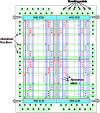Toward 100 Mega-frames per second: design of an ultimate ultra-high-speed image sensor
- PMID: 22315524
- PMCID: PMC3270825
- DOI: 10.3390/s100100016
Toward 100 Mega-frames per second: design of an ultimate ultra-high-speed image sensor
Abstract
Our experience in the design of an ultra-high speed image sensor targeting the theoretical maximum frame rate is summarized. The imager is the backside illuminated in situ storage image sensor (BSI ISIS). It is confirmed that the critical factor limiting the highest frame rate is the signal electron transit time from the generation layer at the back side of each pixel to the input gate to the in situ storage area on the front side. The theoretical maximum frame rate is estimated at 100 Mega-frames per second (Mfps) by transient simulation study. The sensor has a spatial resolution of 140,800 pixels with 126 linear storage elements installed in each pixel. The very high sensitivity is ensured by application of backside illumination technology and cooling. The ultra-high frame rate is achieved by the in situ storage image sensor (ISIS) structure on the front side. In this paper, we summarize technologies developed to achieve the theoretical maximum frame rate, including: (1) a special p-well design by triple injections to generate a smooth electric field backside towards the collection gate on the front side, resulting in much shorter electron transit time; (2) design technique to reduce RC delay by employing an extra metal layer exclusively to electrodes responsible for ultra-high speed image capturing; (3) a CCD specific complementary on-chip inductance minimization technique with a couple of stacked differential bus lines.
Keywords: CCD; ISIS; backside illumination; high sensitivity; high speed; image sensor.
Figures













References
-
- Kosonocky W.K., Yang G., Ye C., Kabra R., Lawrence J., Mastrocolla V., Long D., Shallcross F., Patel V. 360 × 360-Element Very High Burst-Frame Rate Image Sensor. IEEE International Solid-State Circuits Conference (ISSCC), Digest of Technical Papers; San Francisco, CA, USA. February 6–8, 1996; pp. 182–183.
-
- Etoh T.G., Poggerman D., Ruckelshausen A., Theuwissen A.J.P., Kreider G., Folkerts H.O., Mutoh H., Kondo Y., Maruno H., Takubo K., Soya H., Takehara K., Okinaka T., Takano Y., Reisinger T., Author, Lohman C.B. A CCD Image Sensor of 1M frames/s for Continuous Image Capturing of 103 Frames. IEEE International Solid-State Circuits Conference (ISSCC), Digest of Technical Papers; San Francisco, CA, USA. February 4–6, 2002; pp. 46–47.
-
- Etoh T.G., Poggerman D., Kreider G., Mutoh H., Theuwissen A.J.P., Ruckelshausen A., Kondo Y., Maruno H., Takubo K., Soya H., Takehara K., Okinaka T., Takano Y. An Image Sensor Which Captures 100 Consecutive Frames at 1,000,000 frame/s. IEEE Trans. Electron Devices. 2003;50:144–151.
-
- Ohtake H., Hayashida T., Kitamura k., Arai T., Yonai J., Tanioka K., Maruyama H., Etoh T.G. 300,000-Pixel Ultra-High-Speed High-Sensitivity CCD and a Single-Chip Color Video Camera Mounting This CCD. Broadcast Technol. NHK STRL. 2006;28:2–9.
-
- Vo Le C., Etoh T.G., Nguyen H.D., Dao V.T.S., Soya H., Lesser M., Oullette D., van Kujik H., Bosiers J., Ingram G. A Backside-Illuminated Image Sensor with 200,000 Pixels Operating at 250,000 Frames per Second. IEEE Trans. Electron Devices. 2009;56:2556–2562.
MeSH terms
LinkOut - more resources
Full Text Sources
Other Literature Sources

